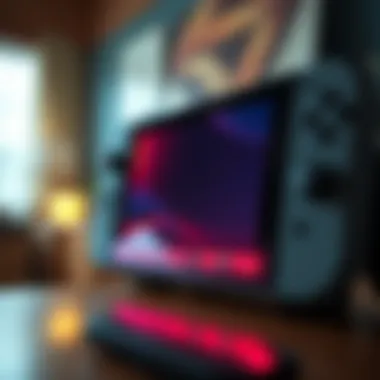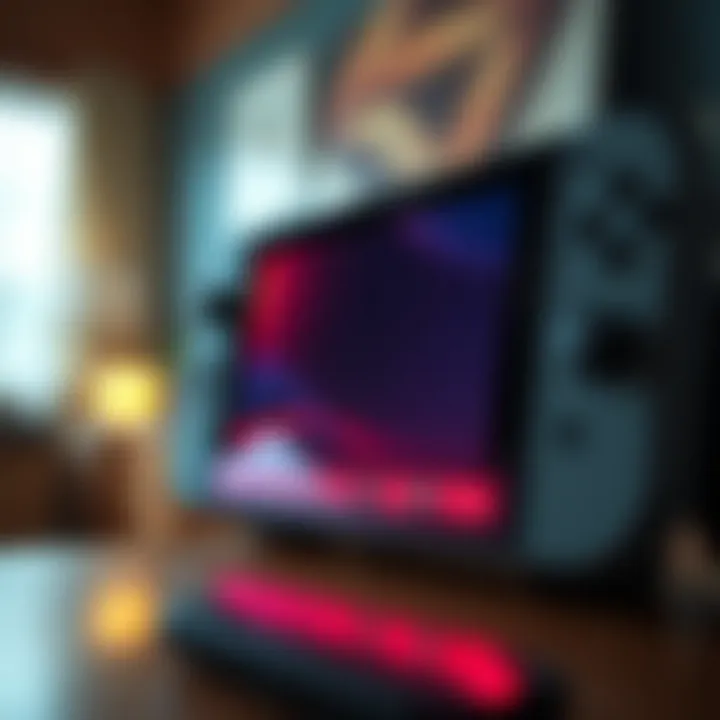A Detailed Look at the Nintendo Switch OLED Model


Intro
The Nintendo Switch OLED model represents a significant step for Nintendo in the realm of hybrid gaming consoles. With a landscape dominated by competitors, Nintendo has aimed to enhance user experience while retaining the charm that its predecessors brought to the table. This new model seems to have the intention of catching the attention of both seasoned gamers and newcomers alike.
At first glance, there are a myriad of features to unpack. From the noticeably larger and brighter screen to enhanced audio capabilities, the OLED model finds its strength in visual and auditory upgrades that promise to deliver an immersive gaming experience. But, how does it stack up against earlier versions of the Switch and its rivals in the market?
As we journey through this extensive comparison, we'll touch on the display technology, battery performance, and portability, assessing whether these enhancements justify the leap in investment. This narrative seeks to cater to both casual players who are interested in the latest gadgets and the hardcore Nintendo fans who wish to uncover all the nuances and features that this upgraded console offers. Prepare to embark on a comprehensive exploration of the Nintendo Switch OLED and discover what sets it apart.
Preface to the Nintendo Switch Family
The Nintendo Switch family stands at the forefront of gaming innovation, creating a bridge between traditional console gaming and the dynamic world of handheld play. This versatility has broad implications for how games are experienced, spanning across audience groups from casual gamers to hardcore enthusiasts. By offering both compact portability and the ability to connect to a television, the Switch family has sculpted a unique niche in the gaming landscape.
Overview of the Nintendo Switch Standard Model
When the Nintendo Switch standard model launched in 2017, it was a game changer. It brought forth a hybrid gameplay experience, allowing users to switch seamlessly between handheld and docked mode. With a 6.2-inch multi-touch capacitive display, the resolution stood at a respectable 720p in handheld mode, and 1080p when docked. The joy-cons provided an innovative control scheme, appealing colors, and detachable functionality. This model resonated with many, prompting a cultural renaissance for Nintendo as they tapped into broader demographics effectively.
Moreover, the local multiplayer capabilities were, and still are, a strong selling point. Friends and family can connect multiple devices, making it ideal for parties and get-togethers. Yet, this model had its share of downsides — issues like battery life and screen quality were often brought to light by avid gamers. Nevertheless, the standard Switch effectively kicked off a new era for console gaming.
Evolution of the Nintendo Switch Lite
As an evolution of the Nintendo Switch standard model, the Nintendo Switch Lite catered specifically to handheld gamers. Released in 2019, it targeted a different segment of the market. The Switch Lite is smaller, lacking the detachable joy-cons and TV dock functionality. This means the system is light, weighing in at just about 0.61 pounds. The 5.5-inch screen offers a vibrant visual experience, although it sacrifices versatility for the sake of compactness.
Despite some limitations, the Lite became a popular choice for those looking solely for handheld gaming. It opened the door for those who may have felt intimidated by the full-priced flagship model. Priced attractively, it proved to be an excellent introduction for younger audiences or those just dipping their toes into gaming. The Switch Lite encapsulated a refined philosophy, emphasizing an all-portable design while still supporting a vast library of games.
Preamble of the Nintendo Switch OLED Model
In 2021, Nintendo introduced the OLED model, a refinement of both earlier versions aiming to enhance the gaming experience significantly. The 7-inch OLED display offers richer colors and deeper contrasts compared to its predecessors, which is critical for immersive play, particularly for games featuring stunning visuals. Battery life improvements promise longer play sessions as well, addressing one of the major complaints lodged against earlier models.
Users can expect enhanced audio capabilities too, with improved speakers positioned at the bottom of the unit, providing a more robust sound experience compared to the standard model. Additionally, the adjustable stand is a welcome change, giving players more control over their viewing angles in tabletop mode.
Overall, the OLED model is not merely a cosmetic upgrade; it’s designed to optimize the gameplay experience in meaningful ways. The upgrades reflect a thoughtful understanding of user needs, melding practical enhancements with aesthetic ones that stand out. By analyzing these innovations, this article will offer insights not just into the OLED model, but how it fits within the broader Switch family context.
Display Technology: A Closer Look
The evolution of display technology has a profound impact on the gaming experience, especially with the advent of the Nintendo Switch OLED model. When it comes to gaming, visuals can make or break a title, altering the way stories unfold and environments develop. This section aims to explore the significant aspects of display technology that set the OLED model apart, covering display sizes, the benefits of OLED, and how these elements shape gameplay and immersion.
Comparison of Display Sizes
The Nintendo Switch OLED model sports a 7-inch screen, as opposed to the 6.2-inch display of the original Switch. Even a small bump in size might not sound like a game-changer at first, but the difference is notable when playing. With more screen real estate, users can appreciate finer details in graphics and experience a broader field of view in expansive game worlds.
- Larger Screen: The increase in size enhances gameplay by allowing players to see more action happening around them.
- Size Advantage: For a game like The Legend of Zelda: Breath of the Wild, every inch counts when spotting distant enemies or curiosities in the landscape.
- Portable Convenience: Opting for a larger screen does not compromise portability, as its light weighted design keeps it easy to carry around.
Benefits of OLED Technology
OLED, or Organic Light Emitting Diode, is a type of display that has distinct advantages over traditional LCD screens. The brilliance of OLED lies in its ability to create deeper black levels, vibrant colors, and a better contrast ratio — crucial aspects for any gamer who cherishes visual detail.
- Color Depth: Colors burst forth with life, making gaming sessions aesthetically fulfilling. Games like Mario Kart 8 Deluxe showcase rich hues on the OLED, making tracks appear more vivid.
- Black Levels: Since OLED screens can turn off individual pixels, dark areas in games become more compelling. This is particularly advantageous in horror or atmosphere-heavy titles that rely on shadow play.
- Viewing Angles: Another plus is that OLED screens maintain color integrity at wider angles. This means that players can experience games comfortably from various positions without losing visual fidelity.
Impact on Gaming Experience
The amalgamation of a larger screen and the benefits of OLED technology results in a more immersive and enjoyable gaming experience. Gone are the days of squinting to see what's lurking in the shadows or feeling frustrated by washed-out colors. Instead, players find themselves enveloped in their virtual worlds.
- Enhanced Immersion: The lifelike visuals contribute to a deeper connection with the game narrative.
- Gameplay Dynamics: Games that feature rich graphics and dynamic environments, such as Metroid Dread, take full advantage of the OLED model's capabilities.
- Overall Enjoyment: Therefore, the combination elevates gameplay not just visually but emotionally, creating a richer experience.
"In gaming, seeing is believing. The OLED model doesn’t just present a game; it paints a vivid world full of life."
In summary, understanding the display technology behind the Nintendo Switch OLED model offers clear insights into its advantages over earlier models. As gamers increasingly demand better visuals and performance from their consoles, the OLED model stands as a testimony to how innovation in display tech can elevate the experience.
Audio Advancements in the OLED Model


The audio experience in gaming is often underestimated, overshadowed by graphics and gameplay mechanics. However, sound plays a pivotal role in immersion and overall enjoyment. The Nintendo Switch OLED model brings with it significant audio advancements that are worth delving into for any avid gamer. These enhancements not only elevate the gaming experience but also echo Nintendo's commitment to adapting and innovating their technology in line with modern expectations. Gamers looking to immerse themselves in rich soundscapes will find these audio improvements a deciding factor in their gaming adventures.
New Audio Features Overview
With the OLED model, Nintendo has introduced several new audio features aimed at enhancing the gaming experience. The console comes equipped with enhanced audio output capabilities, allowing for a more nuanced sound that brings games to life. Here are a few noteworthy features:
- Dual Speaker System: The OLED version boasts a new dual speaker system that improves sound clarity and depth. This means players can expect richer sound quality, from thunderous explosions to the subtle rustle of leaves.
- Volume Optimization: The ability to optimize sound levels according to the game type – whether it be vibrant soundtracks or ambient sound effects – allows for a tailored experience.
- Bluetooth Audio Support: For those who love their wireless headphones, improved Bluetooth support ensures minimal latency and better sound transmission.
These upgrades signal a notable leap from the standard model and showcase a commitment to delivering a fuller, more immersive audio experience.
Speaker Quality Enhancements
Delving deeper into sound quality, the speakers in the Nintendo Switch OLED model receive significant upgrades compared to the previous iterations. Here’s what sets them apart:
- Bigger Speakers: The physically enlarged speakers mean more room for sound production. More air can be moved, which translates to a broader frequency range and enhanced bass response.
- Audio Balance Improvement: Testing indicated that the sound balance between lows, mids, and highs is more refined. This equates to clearer dialogues and more vibrant soundtracks.
- Spatial Audio Simulation: Though not true surround sound, improvements in stereo separation create a spatial audio effect, making players feel they are in the center of the action.
These enhancements reflect a desire to enhance the user experience, ensuring game sounds are just as captivating as their visual counterparts.
User Feedback on Audio Performance
Gaining insights from user experiences reveals much about the effectiveness of new audio features in the OLED model. Gamers have taken to forums and social media platforms to share their thoughts:
- Positive Reception of Sound Clarity: Many users have specifically highlighted the improved clarity, mentioning that they can hear even the minutiae that were previously lost in the mix. This is crucial when playing games that rely heavily on audio cues for both atmosphere and gameplay.
- Enhanced Multiplayer Experience: A noted improvement in multiplayer settings has been the ability to distinguish voices of other players from background sounds thanks to better speaker technology.
- General Satisfaction: Overall, user consistently express satisfaction with the audio advancements, stating that for games with heavy narrative elements, such as "The Legend of Zelda: Breath of the Wild" or "Fire Emblem: Three Houses," the emotional impact is heightened due to audio clarity.
In summary, the improvements in audio technology for the Nintendo Switch OLED model are designed to complement its graphical prowess and gameplay. As users revel in richer gaming experiences, it is clear that Nintendo has made significant strides in ensuring their approach to audio keeps pace with innovation in gaming technologies.
Battery Life and Performance
Battery life and performance stand at the core of any handheld gaming console's appeal. For gamers, understanding how long they can play without needing to recharge can greatly influence their experience. The Nintendo Switch OLED model promises not just a seamless gaming experience but also improvements in terms of battery longevity compared to its predecessors. This creates a compelling narrative for both casual players and hardcore enthusiasts alike.
Battery Specifications Across Models
When comparing the battery specifications, it’s worth noting how each model in the Nintendo Switch family stacks up:
- Nintendo Switch Standard Model:
- Nintendo Switch Lite:
- Nintendo Switch OLED Model:
- Battery life ranges from approximately 4.5 to 9 hours, largely depending on the game being played. For instance, a game like The Legend of Zelda: Breath of the Wild significantly draws more power compared to simpler titles.
- Features a similar battery range but typically lasts slightly less due to its smaller screen and lower power consumption in handheld mode.
- Offers a battery life of about 4.5 to 9 hours as well, yet its design helps with thermal management and efficiency during gameplay, possibly edging towards the higher end of that scale more frequently.
This subtle tweak might not seem like a sea change, but when your evening gaming stretches past a few hours, it definitely makes a difference. It's worth highlighting that even though battery specs appear similar on paper, the OLED's efficiency improvements contribute to a more satisfying session.
Real-World Battery Performance Analysis
In practical use, battery performance can vary widely based on several factors, including game choice and local settings. Reviewers and users alike have noted interesting findings:
- Usage in Different Modes:
- Heat Generation:
- In handheld mode, many reports suggest that games tend to consume battery faster, particularly graphically intense titles. On the other hand, lighter games can stretch battery life impressively.
- The OLED model appears better at keeping cool, which contributes to sustaining battery life. One user shared experiences with prolonged sessions, noting less drain thanks to improved thermal regulation.
In an age where players often engage in quick gaming sessions amidst other commitments, any efficiency gain balances out nicely, allowing for more flexible gaming solutions.
Impact on Extended Play Sessions
Extended play can often be a make-or-break aspect for gamers. The question arises: how does the Switch OLED tackle marathon sessions?


- Comfort Factor: In ergonomic terms, the OLED model's enhancements allow for comfortable long periods of gameplay. Its display size begs to be utilized without feeling fatigued due to brightness or visuals.
- Battery Reassurance: With the base performance remaining similar across models, yet experience showing that the OLED can maintain certain edge conditions better, players can expect more reliable endurance during these extended sessions.
In sum, a gamer engaging in a lengthy session of Animal Crossing New Horizons can keep going without constantly glancing at their battery meter, a sight none too pleasant during epic quests.
For anyone considering which model to invest in based on battery life and performance, the switch to OLED offers advantages that cannot be easily dismissed. As we move forward, it becomes clear that each model appeals to varied players based on their styles and needs.
Portability: Weight and Design Considerations
Portability has become a key focus in the gaming landscape, especially as players increasingly seek flexibility in their gaming experiences. The Nintendo Switch models, especially the OLED variant, have catered to this desire, providing gamers the chance to play literally anywhere. This section digs into the weight and design aspects that define the Nintendo Switch OLED Model, alongside its predecessors, shedding light on how such elements influence usability for both casual and hardcore gamers.
Weight Comparisons Between Models
When considering any portable device, weight plays an undeniable role. The original Nintendo Switch weighs approximately 0.88 pounds (or about 0.40 kg), while the OLED model tips the scales slightly heavier at around 0.93 pounds (0.42 kg). While that may seem like just a hair’s difference, in real-world use, it can affect comfort during prolonged play sessions.
The extra weight in the OLED could be attributed to its more robust battery and enhanced display technology. Though this slight increase could be negligible for many, for individuals who are gaming on the go, every ounce counts. Carrying the console in a bag for a day out or during commutes becomes a consideration; gamers might find one model slightly more comfortable to lug around than the other. However, the design upgrades integrated into the OLED model tend to make it feel sturdier, negating some of that additional heft.
Design Upgrades in the OLED Model
The design of the Nintendo Switch OLED Model has been thoughtfully reengineered, flaunting several upgrades over its predecessors. The centerpiece of this model is undoubtedly its 7-inch OLED screen, which not only improves visuals but also integrates seamlessly into a sleeker body. Larger bezels have been trimmed down, resulting in a more immersive view without needing to sacrifice portability.
Another notable design improvement is the adjustable stand, which is wider and more stable than the one found on the original Switch. This solid stand lets players tilt their consoles at various angles, enhancing the tabletop gaming experience. Moreover, the OLED model has improved speaker placements, contributing to overall sound quality without making the device bulkier. Thus, while there might be a minor weight increase, the design modifications likely translate into a more favorable user experience.
User Preferences for Console Design
In today's market, user feedback continuously shapes the evolution of gaming consoles, particularly with regard to design. Many gamers prioritize attributes such as aesthetics, functionality, and comfort. The sleek aesthetic of the Nintendo Switch OLED Model appeals to both old fans and newcomers alike. Its understated elegance without flashy colors appeals to a more mature audience, while the vibrant display caters to those who appreciate crisp and clear visuals.
Additionally, the ability to easily dock and undock the device has become a crucial feature for players who switch from handheld to television mode frequently. Users express preferences for a balance between style and practicality, and the OLED model seems to strike that delicate chord. This reflects a broader trend in consumer electronics where design is no longer just skin-deep; it needs to extend into functionality and real-world application.
“A console should feel like an extension of you, something you can take anywhere without feeling the drag.”
The Nintendo Switch OLED Model's design and weight considerations undoubtedly address these trends in user preferences, showcasing Nintendo's commitment to refining their systems based on what the community desires.
Game Compatibility and Performance
In the gaming world, compatibility can make or break a system. For the Nintendo Switch OLED model, understanding how it stands against its predecessors and other consoles is crucial for any gamer or enthusiast. The flexibility of the Nintendo Switch ecosystem allows players to enjoy a vast library of games, but nuances in performance can vary greatly across different models. This section delves into the important aspects of game compatibility and performance, focusing on what makes the OLED model a noteworthy contender in the market.
Backward Compatibility Insights
One of the shining features of the Nintendo Switch family is its backward compatibility. The OLED model continues this tradition, providing gamers the ability to play a wide range of existing Nintendo Switch titles without any hiccups. Players can dive into classics like "The Legend of Zelda: Breath of the Wild" or "Super Mario Odyssey" right out of the box.
This capability not only enhances the value of upgrading to the OLED model but also ensures that players are not left in the dust with their previously purchased digital and physical games. A significant point to consider is how Nintendo has designed its entire library to function seamlessly across models, which speaks volumes about their commitment to user experience.
"Backward compatibility is not just a feature, it's a lifeline for gamers transitioning between systems."
Performance Differences in Existing Games
While the OLED model might not boast a stronger CPU than its predecessors, gamers will notice subtle yet impactful differences in performance. The key area where the OLED model shines is in display quality, thanks to its vibrant OLED screen, which enhances visual fidelity significantly. Bright colors and deeper blacks elevate the overall gaming experience, especially in visually rich games like "Metroid Dread" and "Splatoon 3".
However, when it comes to loading times and frame rates, the OLED doesn’t necessarily offer a performance boost compared to the standard Switch. Titles like "Animal Crossing: New Horizons" or "Fire Emblem: Three Houses" may still run the same as they do on the standard model. It’s clear that the OLED model’s main edge lies in visuals rather than raw performance metrics, making it more of a pleasure for the eyes than a powerhouse in terms of specifications.
Upcoming Game Releases Focused on the OLED Model
As the gaming landscape continues to evolve, Nintendo has also been gearing up for future releases that capitalize on the strengths of the OLED model. Anticipated titles such as "Bayonetta 3" and potential sequels to beloved franchises have been hinted to harness the enhanced graphical capabilities of the OLED display, promising a more immersive experience. While specific details are still under wraps, developers are certainly aware of the superior display technology, which may result in visually stunning renditions of beloved gameplay mechanics.
Moreover, with an increasing number of games being optimized for the latest consoles, it is likely that upcoming releases will tailor their performance to suit the OLED's display. This not only ensures a visually striking experience but also signals a shift in how developers might approach console performance in the future. Keeping an eye on these upcoming games is essential for any dedicated Nintendo fan who desires the best experience available.
In summary, the Nintendo Switch OLED model stands as a testament to seamless backward compatibility, offers notable visual performance enhancements, and promises a future filled with potential game releases tailored specifically to its strengths. As such, it’s a pivotal consideration for anyone contemplating their next gaming investment.
User Interface and Experience


When considering any gaming console, the user interface and experience are paramount in shaping how gamers interact with their devices. Nintendo has always placed emphasis on creating a seamless experience for users, and this remains a pivotal aspect for the OLED model. The menu layout, ease of navigation, and overall intuitiveness contribute significantly to the satisfaction users derive from the console. When it comes to the Nintendo Switch OLED model, there are notable enhancements that influence how gamers relate to their gaming experiences.
User Experience Improvements
The Nintendo Switch OLED model brings with it a noticeable upgrade in user experience. Designed to make navigation more intuitive, it enhances the gaming experience right from the moment the user boots up the console. The display is larger, offering a more immersive feel that complements the user interface, which has been simplified for easier access to features.
For example, the redesigned home screen allows players to easily locate their favorite games or software with just a few clicks. This improvement reduces frustration and saves time, as avid gamers know that every second counts, especially when transitioning between game sessions. The addition of new widgets further personalizes the experience, allowing users to see updates without endless scrolling. This way, important notifications are just a glance away.
In sum, these refinements don't just elevate usability; they also enhance engagement and joy during gaming sessions. It’s these little things that make the difference for players who enjoy spending hours on their console.
Accessibility Features for Gamers
Accessibility is a topic gaining traction in gaming, and the Nintendo Switch OLED model does not fall behind. The approach taken here reflects a commitment to inclusivity. Recognizing that gamers come with diverse needs, Nintendo has worked to ensure that all players can find enjoyment, regardless of their abilities.
A few key features stand out, such as the ability to adjust the screen brightness for those who may be sensitive to light or require different settings for comfortable viewing. Additionally, options for customizing control schemes mean that players can tailor gameplay mechanics to suit their individual preferences. This is especially useful for those who may have motor skill challenges or disabilities.
Beyond just visual adjustments, the introduction of simple voice commands in some games has allowed players to navigate menus and perform actions without needing to rely solely on traditional controls. This kind of forward-thinking truly opens doors for gamers who might have previously struggled to engage fully with console gaming.
Customization Options Available
Every gamer has their unique preferences, and the Nintendo Switch OLED model recognizes this with a wealth of customization options. Tailoring the interface can enhance feelings of ownership and personal connection to the console. Users can rearrange their game library, set favorites, and even personalize their icons to make the system feel more like their own.
Moreover, the interface allows for various themes that can alter the overall ambiance of the dashboard. Whether a player prefers a sleek, minimalistic look or something more vibrant and colorful, there’s a theme to suit every taste.
Customization extends beyond appearances. Users can also create game groups or folders, organizing their library according to preference or genre. This lets gamers sift through their titles quickly without spending half their session searching for that beloved classic.
"A well-designed user interface doesn’t just look good; it hides complexity and lets gamers focus on what truly matters—the fun!"
For further details on user experience evolution in gaming, you can refer to Wikipedia.
Final Thoughts on the Nintendo Switch OLED Model
The Nintendo Switch OLED model represents a significant chapter in Nintendo's gaming legacy. It's not just an upgrade—it's an invitation for players to immerse themselves in a console that redefines portable gaming while honoring the heritage of its predecessors. In considering the OLED model, several specific elements stand out that invite gamers and enthusiasts alike to ponder its place in the gaming ecosystem.
Overall Value Assessment
When assessing the overall value of the Nintendo Switch OLED model, it's essential to look at the improvements in visual fidelity and audio quality that come bundled with this console. The vibrant OLED screen offers richer colors and deeper blacks, which help elevate the experience in titles like The Legend of Zelda: Breath of the Wild or Metroid Dread. This jump in quality can turn even casual gaming into an engrossing venture.
However, the price point could be a sticking point for some players. The OLED model does come at a heftier cost compared to the standard Switch, yet many find the enhanced graphics and improved audio performance worth every penny.
The improvements in battery life and portability also add to the value. Gamers who appreciate taking their console on-the-go will benefit from the redesigned kickstand, allowing for better stability during tabletop gaming sessions. Additionally, many users rave about the substantial upgrades in usability, which encourages more playtime without needing to rush through levels due to battery constraints.
Target Audience Considerations
Identifying the right audience for the Nintendo Switch OLED model is crucial. This device caters not only to long-time Nintendo aficionados but also to new players who are looking for a rich gaming experience. Casual gamers might appreciate the sleek design and the convenience it offers, while hardcore fans will appreciate the ability to enjoy their favorite titles in a new light, thanks to the improved graphics and sound.
Moreover, families that enjoy multi-player gaming will find the enhanced screen size beneficial for group play. The broader visual real estate really shines when multiple players are huddled around the console during gaming sessions.
However, it's worth noting that gamers who play primarily at home with a robust setup might not find the OLED model as compelling, especially if they have already invested in previous models. Thus, understanding the needs and habits of potential buyers becomes integral in determining whether this model fits into their gaming lives.
Future Outlook for Nintendo Switch Lineup
Looking ahead, the Nintendo Switch OLED model could serve as both a benchmark and a bridge to future innovations in the Switch lineup. As technology continues to evolve, Nintendo's commitment to portable gaming means we may see even more refinements in upcoming models. If history serves as any indication, we should anticipate advancements that mesh seamlessly with the market’s direction.
More importantly, the Nintendo community is eager for fresh titles. Upcoming releases are expected to leverage the OLED's stunning display capabilities, ensuring that future games take full advantage of what the hardware has to offer. As developers get accustomed to the OLED's potential, we are likely to see richer game worlds and enhanced gameplay experiences.
In sum, the Nintendo Switch OLED model is not just an incremental upgrade; it embodies the evolution of gaming experiences. As Nintendo teeters on the brink of what's next, players are left to wonder how not only this model but the future of the Switch line will shape their adventures ahead.
"The Switch OLED is like stepping into a redesigned world, one that seems to vibrate with color and sound, begging you to explore every pixel."
For further information, consider visiting these resources:
- Wikipedia on Nintendo Switch
- Britannica on video game consoles
- Discussions on Reddit about the Switch OLED and user experiences can be found here.
This should give you a comprehensive wrap-up of a truly innovative handheld console that is changing how fans view gaming on-the-go.



